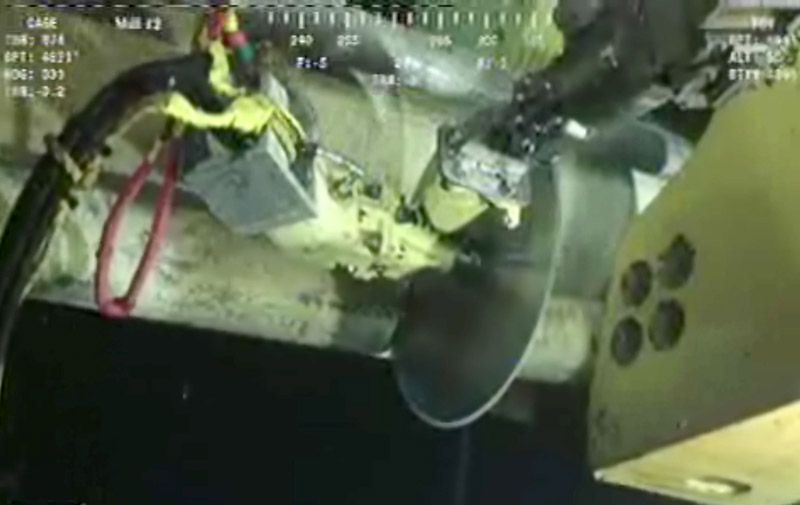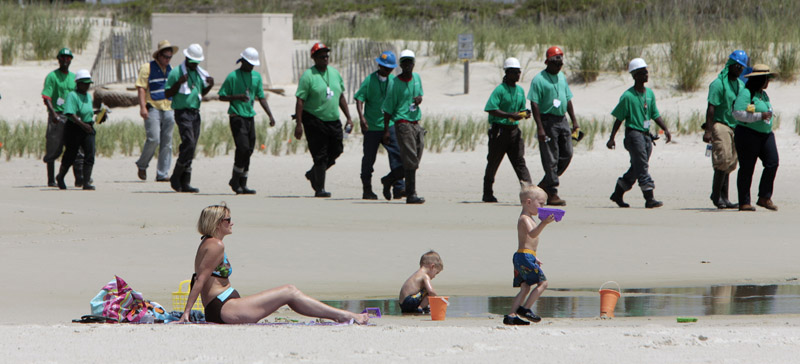PORT FOURCHON, La. — As the crude crept closer to Florida, the risky effort to contain the nation’s worst oil spill hit a snag today when a diamond-edged saw became stuck in a thick pipe on a blown-out well at the bottom of the Gulf.
Coast Guard Adm. Thad Allen said the goal was to free the saw and finish the cut later in the day. This is the latest attempt to contain – not plug – the gusher. The best chance at stopping the leak is a relief well, which is at least two months from completion.
“I don’t think the issue is whether or not we can make the second cut. It’s about how fine we can make it, how smooth we can make it,” Allen said.
If the cut is not as smooth as engineers would like, they would be forced to put a looser fitting cap on top of the oil spewing out. This cut-and-cap effort could temporarily increase the flow of oil by as much as 20 percent, though Allen said officials wouldn’t know whether that had happened until the cut could be completed.
Engineers may have to bring in a second saw awaiting on a boat, but it was not immediately clear how long that could delay the operation. Live video of the saw showed oil spitting out of the new cut, and crews were shooting chemicals to try to disperse the crude. The cap could be placed over the spill as early as today.
The effort underwater was going on as oil drifted close to the Florida Panhandle’s white sand beaches for the first time and investors ran from BP’s stock for a second day, reacting to the company’s weekend failure to plug the leak by shooting mud and cement into the well, known as the top kill.
The Justice Department also has announced it started criminal and civil probes into the spill, although the department did not name specific targets for prosecution.
Shares in British-based BP PLC were down 3 percent this morning in London trading after a 13 percent fall the day before. BP has lost $75 billion in market value since the spill started with an April 20 oil rig explosion and analysts expect damage claims to total billions more.
In Florida, oil was about seven miles south of Pensacola beach, Allen said.
Thunderstorms were making it difficult to track the slick, Escambia County emergency director John Dosh said, and officials hoped the weather would clear so they could get an aerial view.
“We are looking at a Wednesday to Friday shoreline impact, but there is a line of uncertainty that depends on the wave action and the winds,” Dosh said.
“Today we are in a monitoring mode.”
Emergency crews began scouring the beaches for oil and shoring up miles of boom, though choppy waters from thunderstorms could send the oil over the protective lines. County officials are using the boom to block oil from reaching inland waterways but plan to leave beaches unprotected because they are easier to clean up.
“It’s inevitable that we will see it on the beaches,” said Keith Wilkins, deputy chief of neighborhood and community services for Escambia County.
The oil has been spreading in the Gulf since the Deepwater Horizon rig exploded six weeks ago, killing 11 workers and eventually sinking. The rig was being operated for BP, the largest oil and gas producer in the Gulf.
Crude has already been reported along barrier islands in Alabama and Mississippi, and it has polluted some 125 miles of Louisiana coastline.
Allen, the national incident commander for the spill, said the threat of oil hitting the coast was shifting east and skimmer vessels would be working offshore to intercept as much crude as possible.
Earlier this week, BP officials said they were concentrating cleanup efforts in Louisiana because they did not expect oil to reach other states. The company has set up floating hotels on barges to house cleanup crews closer to the Louisiana shores.
More federal fishing waters were closed, too, another setback for one of the region’s most important industries. More than one-third of federal waters were off-limits for fishing, along with hundreds of square miles of state waters.
Fisherman Hong Le, who came to the U.S. from Vietnam, had rebuilt his home and business after Hurricane Katrina wiped him out. Now he’s facing a similar situation.
“I’m going to be bankrupt very soon,” Le, 53, said as he attended a meeting for fishermen hoping for help. “Everything is financed, how can I pay? No fishing, no welding. I weld on commercial fishing boats and they aren’t going out now, so nothing breaks.”
Le, like other of the fishermen, received $5,000 from BP PLC, but it was quickly gone.
“I call that ‘Shut your mouth money,'” said Murray Volk, 46, of Empire, who’s been fishing for nearly 30 years. “That won’t pay the insurance on my boat and house. They say there’ll be more later, but do you think the electric company will wait for that?”
BP may have bigger problems, though.
Attorney General Eric Holder, who visited the Gulf on Tuesday, would not say who might be targeted in the probes into the largest oil spill in U.S. history.
The federal government also ramped up its response to the spill with President Barack Obama ordering the co-chairmen of an independent commission investigating the spill to thoroughly examine the disaster, “to follow the facts wherever they lead, without fear or favor.”
The president said that if laws are insufficient, they’ll be changed. He said that if government oversight wasn’t tough enough, that will change, too.
BP has tried and failed repeatedly to halt the flow of the oil, and the latest attempt like others has never been tried before a mile beneath the ocean. Experts warned it could be even riskier than the others because slicing open the 20-inch riser could unleash more oil if there was a kink in the pipe that restricted some of the flow.
“It is an engineer’s nightmare,” said Ed Overton, a Louisiana State University professor of environmental sciences. “They’re trying to fit a 21-inch cap over a 20-inch pipe a mile away. That’s just horrendously hard to do. It’s not like you and I standing on the ground pushing – they’re using little robots to do this.”
Send questions/comments to the editors.





Success. Please wait for the page to reload. If the page does not reload within 5 seconds, please refresh the page.
Enter your email and password to access comments.
Hi, to comment on stories you must . This profile is in addition to your subscription and website login.
Already have a commenting profile? .
Invalid username/password.
Please check your email to confirm and complete your registration.
Only subscribers are eligible to post comments. Please subscribe or login first for digital access. Here’s why.
Use the form below to reset your password. When you've submitted your account email, we will send an email with a reset code.